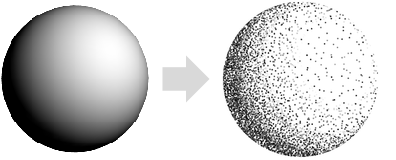is a three-dimensional graphics directive specifying that objects that follow are to be drawn using small dots.
uses the density d of shading.
StippleShading[col]
uses dots with the specified color col.
StippleShading[d,col]
uses dots of color col with the density d of shading.


StippleShading
is a three-dimensional graphics directive specifying that objects that follow are to be drawn using small dots.
uses the density d of shading.
StippleShading[col]
uses dots with the specified color col.
StippleShading[d,col]
uses dots of color col with the density d of shading.
Details

- StippleShading is also known as stippling.
- StippleShading is typically used to achieve a drawing effect in which dots are used to convey the shape, texture and lighting of a three-dimensional object.
- StippleShading[d,col] specifies that dots of color col should vary with overall density d.
- The density of dots is driven by the luminosity of the surface. Less dense areas indicate high luminosity.
- The density d is between 0 and 1. A higher density indicates more dots per area.
- The color col can be defined by RGBColor, Hue or any other color specification.
- In StippleShading[d], the color of dots is taken to be Black.
- StippleShading[col] uses a density of 0.5.
- StippleShading[] is effectively equivalent to StippleShading[0.5,Black].
- The setting Lighting"Accent" uses a directional light and faithfully reproduces colors on the surface.

Examples
open all close allBasic Examples (4)
Scope (11)
Basic Uses (5)
Specification (3)
StippleShading with no arguments uses gray tones:
Apply stipple shading to the unit sphere with different densities:
Lighting (3)
StippleShading works with all types of lights:
Use "Accent" lighting to faithfully reproduce colors on the surface:
Related Guides
History
Text
Wolfram Research (2020), StippleShading, Wolfram Language function, https://reference.wolfram.com/language/ref/StippleShading.html.
CMS
Wolfram Language. 2020. "StippleShading." Wolfram Language & System Documentation Center. Wolfram Research. https://reference.wolfram.com/language/ref/StippleShading.html.
APA
Wolfram Language. (2020). StippleShading. Wolfram Language & System Documentation Center. Retrieved from https://reference.wolfram.com/language/ref/StippleShading.html
BibTeX
@misc{reference.wolfram_2025_stippleshading, author="Wolfram Research", title="{StippleShading}", year="2020", howpublished="\url{https://reference.wolfram.com/language/ref/StippleShading.html}", note=[Accessed: 22-December-2025]}
BibLaTeX
@online{reference.wolfram_2025_stippleshading, organization={Wolfram Research}, title={StippleShading}, year={2020}, url={https://reference.wolfram.com/language/ref/StippleShading.html}, note=[Accessed: 22-December-2025]}